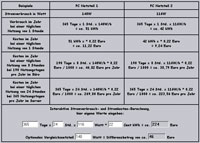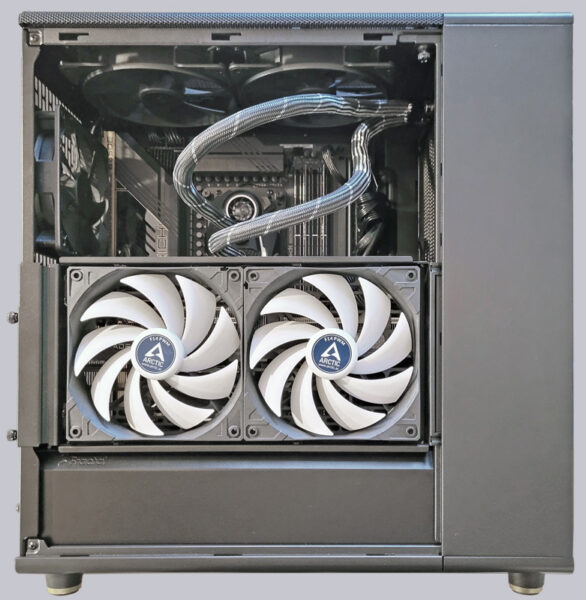
Practical testing …
For the practical testing of the Seasonic Vertex GX-850 power supply, we use our AMD Ryzen 7000 test system, which consists of the following components.
| Motherboard | ASRock B650E Taichi |
| SSD | Crucial P5 Plus 1TB M.2 PCIe 4.0 NVMe-1.4 CT1000P5PSSD8 |
| CPU | AMD Ryzen 5 7600X |
| RAM | 2x 16GB DDR5-5600 from Crucial |
| Graphics card | AMD Radeon RX6800XT with 373W Powerlimit |
| Case | Fractal Design North |
| Cooler | Arctic Liquid Freezer II 360 |
| Operating system | Windows 11 – Version 22H2 |
As expected, there were no problems when installing the power supply, but the thick AWG16 cables did not exactly make themselves felt positively due to their high stiffness. Especially when using the 12VHPWR connector, care should be taken when laying the cables not to fall below the recommended bending radii and not to allow high forces to act on the connector. Due to the generous cable lengths of 610mm (motherboard) to 950mm (4-way SATA cable), there should also be no problems when used in full towers. The Vertex series probably feels most comfortable there. All connectors could be plugged in and unplugged cleanly without wobbly contacts even being an issue.
The voltages …
Before we look at the voltages in detail, we take a look at the voltage tolerances according to the ATX specification. These are +/-5% of the nominal value for the +5V and +12V lines, which results in the following limits. The power supply color codes and pin assignments are listed in our forum under PC power supply pin assignment.
| Voltage | Tolerance | Minimum | Maximum |
| +3.3V | ±5% | +3.14V | +3.47V |
| -5V | ±10% | -4.5V | -5.5V |
| +5V | ±5% | +4.75V | +5.25V |
| -12V | ±10% | -10.8V | -13.2V |
| +12V | ±5% | 11.4V | 12.6V |
Seasonic has challenged themselves to keep the voltages of +12V, +5V and +3.3V within +/-3% under any load conditions. Our following stress test shows whether this is also adhered to.
Voltages with load …
For the stress test of the Vertex GX-850, we start Furmark’s Torture Test to permanently and completely load the AMD RX6800XT graphics card, whose power limit we have increased to 373W. At the same time, we run the Prime 95 Blend Test, which loads the CPU with 130W. The wattmeter at the wall socket shows a power consumption of 699 watts under these conditions. That is 11 watts less than another manufacturer’s 750 watt power supply that is also 80 Plus Gold certified and that we used for comparison purposes. We can thus attest the Seasonic Vertex GX-850 a good efficiency. To use the optimal efficiency range of a PC power supply, the load should be in the range of 50%. Above or below that, the efficiency is slightly worse, but an independent institute has certified the Vertex GX-850 to always have an efficiency of over 90% at 230V mains voltage in the entire load range between 20% and 80%, which is an excellent value. Those looking for the highest power supply efficiency for their PC can reach for the even higher quality Vertex PX series, where the power from the socket is used a few more percent better than the already excellent GX series.
During test operation, the current voltages were recorded with the HWiNFO program. Despite the considerable performance fluctuations between idle and full load operation, the determined minimum and maximum values were surprisingly close to each other.
| Voltage | Minimum | Maximum | Variation |
| 3.3V | 3.280V | 3.344V | 1.9% |
| 5V | 4.992V | 5.016V | 0.5% |
| 12V | 12.038V | 12.197V | 1.3% |
Our software measurement does not completely record every voltage spike, but we can already recognize the voltage stability and it seems to be excellent in the Seasonic Vertex GX-850. We determined fluctuations between 0.5% and 1.9%, which is clearly below the values of the comparison power supply, where the fluctuations are between 1.3% and 2.9% under the same load conditions.
Emissions …
Depending on the ambient temperature, the integrated fan of the Vertex GX-850 should stand still in hybrid mode up to about 400W output power and thus not cause any noise. But even if the liquid-bearing and temperature-controlled fan provides the necessary cooling in the PSU, it cannot be heard out of a PC that requires 400W of power because it is drowned out by the fans of the graphics card, the CPU and the case fans. In tight spaces, the PSU fan can optionally be left to rotate continuously, allowing it to be used as a case fan. The dreaded coil whine (also called coil whine) could not be detected at any time during the test, regardless of whether the load was high or low. Unpleasant odors are very limited in both the power supply and the cables, even though they cannot be completely denied.
How high the power costs of the PC are with or without overclocking depending on the performance and running time can be calculated with our interactive PC power cost calculator:

Interactive power consumption Calculator
Seasonic Vertex GX-850 Result and general impression …


